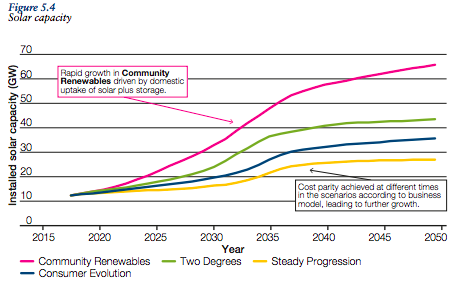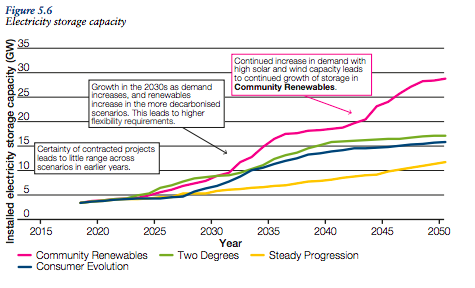National Grid expects “significant solar growth” for decades to come, even in its most conservative modelling of the UK’s future energy mix.
According to its annual Future Energy Scenarios report, solar capacity will double from around 14GW today, to at least 28GW by 2050. It could reach 65GW.

A more immediate effect of solar’s rise is on minimum electricity demand on the transmission network, which is starting to happen on summer afternoons rather than early mornings. That happened for the first time in March 2017, and National Grid expects it to become a regular occurrence.
Balancing the system at times of low transmission demand is “challenging”, according to National Grid, because many large power stations cannot be turned on and off quickly.
However, the System Operator said this is where electric vehicles (EVs) could play a role.
“As some vehicles will not, or cannot, charge overnight there is also an increase in daytime demand. This helps to smooth the within-day electricity demand profile,” states the report.
National Grid models up to 11m EVs on UK roads by 2030, and as many as 36m by 2040 – suggesting virtually all cars would be electric in that scenario.
All scenarios show a high penetration of all-electric vehicles, and all of them feature smart charging to manage peak demand. Vehicle to grid services (V2G), using car batteries to balance the grid, will provide “useful levels of support” after 2030, said National Grid, as much as 8GW by 2040, and 13GW in 2050.
Battery storage

National Grid appears to have again revised storage deployment rates in this year’s FES document, with less than 5GW installed in all scenarios by 2020, compared to around 6GW outlined in last year’s document. Longer term scenarios suggest between 12 and 28GW of storage capacity may be installed by 2050 – but this figure does not include EVs.
Gas
Gas continues to play a significant role in both heat and power generation in the coming decades across all scenarios, some of which could come from hydrogen.
If the high levels of renewable generation modelled in some scenarios materialise, hydrogen could also provide a demand response service to the electricity system. Producing hydrogen via electrolysis requires a lot of power, so could be scheduled for periods of low electricity demand or when there is excess power on the system, states the document. Some electrolysis technologies can be quickly switched on and off, so could potentially be used as fast acting flexibility.
Gas storage
Although producing hydrogen from renewables in that manner could enable a form of gas storage, National Grid underlined the UK’s lack of traditional storage since the closure of Rough.
“Gas storage has an important role to play … in supporting security of supply and providing flexibility in the operation of the gas market,” states the document.
“There has been some recent development of medium-range storage as capacity is increased at existing sites. However, the economics have not been favourable for the development of new storage for some years.”
Demand-side response
The document suggests there will not be much growth of industrial demand-side response (DSR) until post-2020.
It also defines DSR as purely ‘load’ response; turning power consuming equipment on or off, or up or down. Switching to onsite generation does not count.
National Grid also outlines the implications of recent regulatory change on decentalised thermal generation, with cuts to embedded benefits and the UK’s interpretation of the European Medium Combustion Plant Directive (MCPD) leading it to reduce the upper ranges of smaller thermal plant on the system compared to last year’s document. National Grid’s scenarios now suggest between 7-16GW of decentralised thermal plant on the system by 2050.
The UK government’s decision to go further than the MCPD requires and extend NOx limits to smaller generators if they take on new Capacity Market agreements or balancing services contracts, means all small diesel and some gas generation that wish to bid for such contracts will have to fit abatement technologies.
“For some projects, the cost may outweigh future revenues, leading to project closure,” states National Grid.
See the document here.
Related stories:
As solar generation makes history, National Grid starts to feel the burn
Medium Combustion Plant Directive takes back-up generators out of DSR
National Grid slashes long term estimates for battery storage
Hydrogen: The great white hope?
Electric vehicle boom no sweat, says National Grid
EVs ‘could provide 11GW of flex’
Flexitricity chief: UK has enough spare power electrify every car on the road
Nissan: Vehicle to grid services will not drain EV batteries
Lord Redesdale: Idea of EVs as energy storage is “complete crap”
Follow us at @EnergystMedia. For regular bulletins, sign up for the free newsletter.



